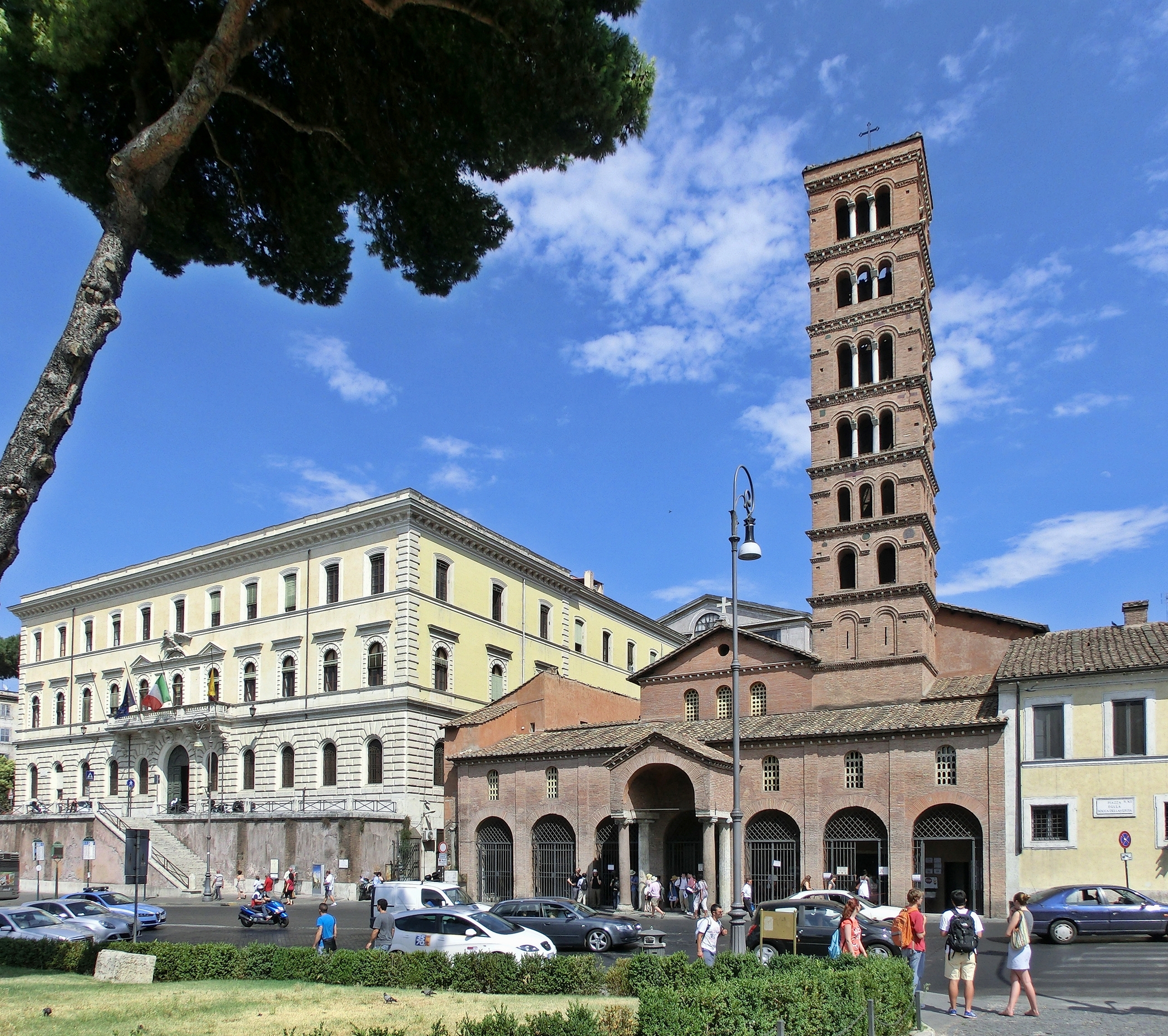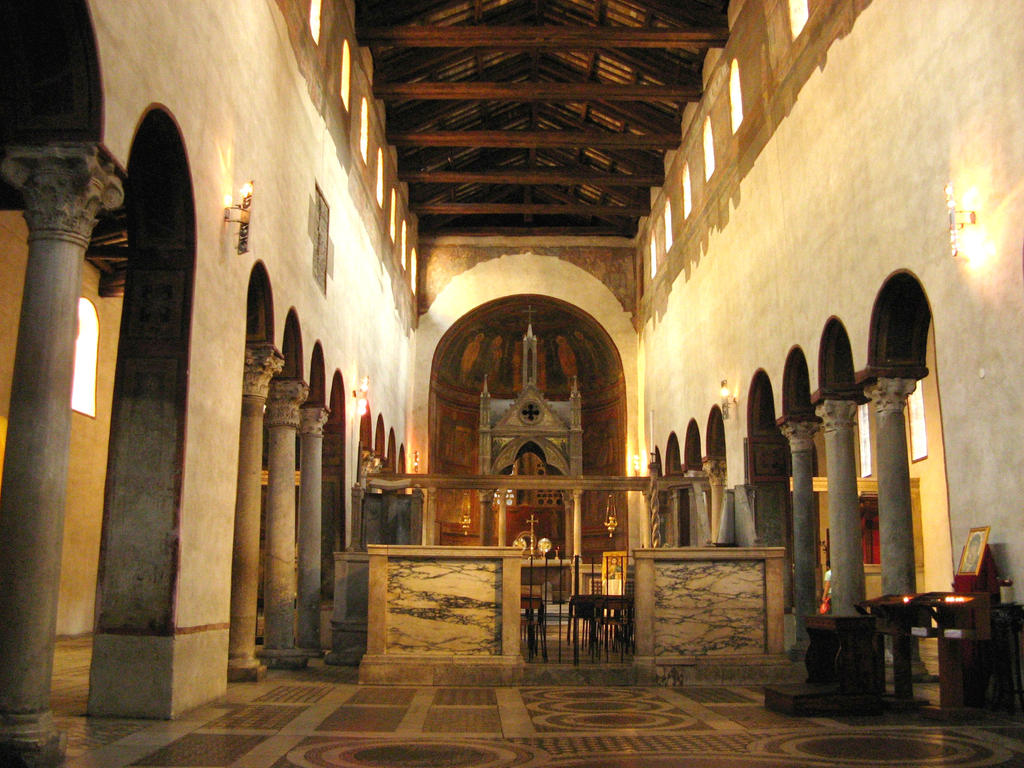Santa Maria in Cosmedin
41.88805555555612.481666666667Koordinaten: 41 ° 53 ' 17 " N, 12 ° 28' 54" E
The Basilica of Santa Maria in Cosmedin (Latin Sanctae Mariae in Cosmedin ), originally Santa Maria in Schola Graeca, is a church of the diocese of Rome in Rome near the Tiber to Piazza Bocca della Verità. Patrona of the church is Mary. The church was consecrated in the 6th century. It is one of the Melkite Greek Catholic Church today.
Predecessors
No later than the 6th century BC was taken on a Tiber transition with the Boarium Forum, the first and most important commercial and transport hub of Rome. At this market over the centuries a number of religious and public buildings were constructed, of which even the Temple of Portunus (formerly known as Temple of Fortuna Virilis ) and the Temple of Hercules Victor are (formerly known as the Temple of Vesta ) was obtained today.
In the area of the present church were three other temples dedicated to Hercules: The Ara Maxima that you want to go back to the founding of the Roman period, the temple of Hercules Invictus and the Temple of Hercules Pompeianus. Since the 1st century AD was next to these temples, the stationing annonae that served the issue of grain to the people. In the East, the Church intervenes in the area that was built by the Circus Maximus.
Under the whole area extending some ancient sewers, including the largest, the Cloaca Maxima.
Architectural History
The stations annonae, originally a portico from the 1st century AD, was renewed by 500. A few decades later, the rooms were bricked between the columns and converted the building into a church which was dedicated to the Virgin Mary. On the sides of the portal of the church and in the left nave wall columns from the stations annonae are still preserved. Because ever since the early days of Rome, the Forum was Boarium settlement area for Greek merchants and therefore in Late Antiquity, the district was named the Schola Graeca, the church of Santa Maria in Schola Graeca was called.
For the first enlargement of the Church under Pope Adrian I to 772 the growth of the Greek community during the period of civil war iconoclasm in Byzantium was the decisive factor, which many Greek refugees came to Rome. He allowed for the expansion demolish the temple of Hercules Pompeianus to use the foundations for the 17 m to 35 m length extended church can. In addition, the now three-nave church was as eastern end an apse flanked by two side apses. Next, a three-aisled crypt was also sunk into the Tuffquader the old podium.
Hadrian I equipped the church with marble work and mosaics. From the reconstruction gradually replaced the name 'Santa Maria in Cosmedin ' the old name. For the name ' Cosmedin ' There are several explanations: After an argument, he comes from a place in Byzantium named ' Kosmidion ' from. According to another version, the name derives from the Greek word Cosmedin for jewelry. The epithet would apply in this case, the sumptuously decorated interior.
Under Pope Nicholas I ( 858-867 ), the sacristy, the oratory and the residence of the deacon was added. 1118, Pope Gelasius II renovate the basilica, which had been devastated during an invasion by the Normans. It also was the Campanile. 1200 came the portico added at the entrance.
In 1718 the church was under Giuseppe Sardi Baroque style by letting her set before an elegant, sweeping Rococo façade. 1899 prompted the architect Giovanni Battista Juvenal Romanization, bringing the baroque facade was removed. The present façade is not the original state, whose only idea at the time.
The construction of new roads during the reign of Benito Mussolini, the environment of the church is greatly impaired.
Interior
Inside, the structure of the stations annonae is still clearly visible on the resulting 18 Corinthian columns.
The altar block consists of an antique piece of red granite. The Schola Cantorum is divided by magnificently decorated marble barriers. The floor is decorated like a carpet with Kosmatenarbeiten.
The bishop's throne from 1294 with two presumably ancient lion heads was also designed by the Cosmatesque. It is typical of an early Christian church, it is not the altar, as later, in the apse stands, but the bishop's throne. The altar stood at the time, as here in Cosmedin front of the apse.
Next two marble pulpits, the rotated Paschal candle and created by Cosmati ciborium are obtained. The paintings in the three apses are modern.
In the second chapel of the left aisle, the relics of Valentine of Terni are housed.
Bocca della Verità
The most popular features of the church is called the Mouth of Truth (Italian: Bocca della Verità ), which is situated in the lobby. It is an ancient drain cover the Cloaca Maxima from the 4th century BC, showing the river-god Triton.
According to legend, everyone loses his hand, which she put into his mouth and not telling the truth. The Mouth of Truth was known primarily through the film A heart and a crown with Gregory Peck and Audrey Hepburn.
Opening times
The church is open during the summer from 9:30 bis 18:00 clock and in winter from 9:30 bis 17:00 clock clock.
Others
The Campanile served as a model for the tower of the historicist Peace Church in Potsdam.
Cardinal deacons
(currently vacant)
Gallery
Paschal candle with Kosmatenarbeit
Look in the crypt
Altarziborium
Floor Cosmatesque








